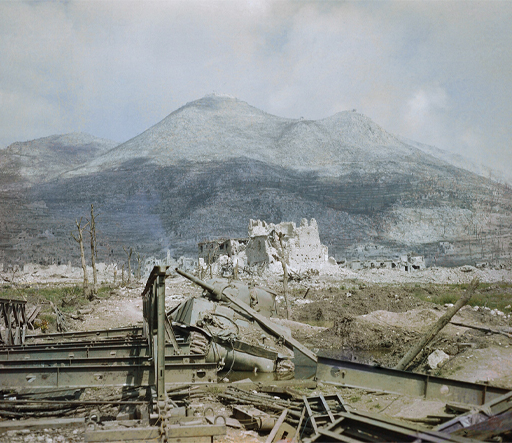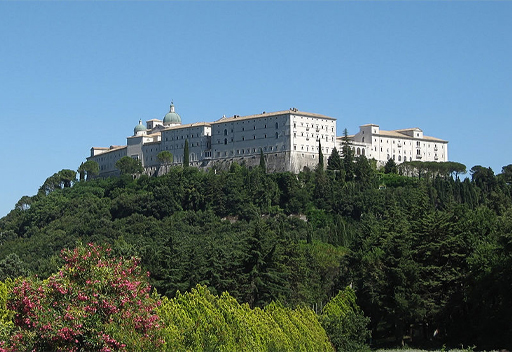2 Monte Cassino Abbey
Before outlining the case study of Monte Cassino, you should note that, because of constraints, the account you will read is a simplification of the truth. In reality, events were more complex than this description suggests. In addition, the decisions you will examine were made under extremely high pressure, with incomplete and conflicting information, and from a historic perspective which we may not share today. Given this, remind yourself not to draw conclusions or make judgements too hastily or harshly.
Monte Cassino Abbey is a Benedictine monastery which stands on top of a rocky hill near the town of Cassino in Italy (about 80 miles southeast of Rome). The abbey has a long and significant history, with three of Monte Cassino’s monks going on to become Popes in later life. The first buildings were established nearly 1500 years ago, although the abbey, as it stands today, has been destroyed and rebuilt several times over (Figure 1).
The most recent destruction of the abbey was by the Allied forces in February 1944, during the Second World War (Figure 2). At the start of the year, the Allied armies had been pushing north towards Rome. However, overtaking the German defensive lines proved more challenging than expected. In particular, the Allied forces faced the difficult task of capturing or circumventing Cassino as they attempted to move up the Liri Valley.

The high mountain peaks around Cassino gave the German army advantageous positions to observe the Allied soldiers’ movements, allowing them to carry out accurate artillery strikes. The destructiveness of these attacks effectively halted the Allied forces’ advance northward.
Between 20 and 22 January, the Allied forces made several unsuccessful attacks on the German lines, with heavy casualties. Although further attempts made throughout the rest of January were more successful, gaining control of the abbey itself proved impossible. Attempted advances were repelled with heavy machine-gun fire from the surrounding slopes.
At this point, there were varying opinions among the Allied forces about whether the abbey itself was occupied by the German military. Some reasoned that, given the accuracy of the German artillery fire, they were probably using it as an observation point. Indeed, some pilots reported seeing evidence of a German presence during flyovers (although others disagreed). It was also argued that, even if the German forces weren’t using the abbey, they could start occupying it at any point. So, destroying the building would still be a valuable military goal.
On the other hand, following a special request from the Vatican, the German army had informed the Allied forces that they would not be including the abbey in their defensive line. In addition, the abbey itself was recorded by the Allied forces as one of Italy’s most important monuments and was given a two-star rating (on a scale of one to three).
Despite these factors, the pressure was building for the Allied forces to bomb the abbey. Both American and British newspapers, such as the New York Times and Daily Mail, ran stories claiming that German soldiers were occupying the abbey. Also, army commanders received letters imploring them to save their soldiers’ lives by destroying the building. In addition, Allied commanders were advised that the abbey had previously been demolished and rebuilt, most recently in the seventeenth century. And, on studying the architecture of the building, they decided that further ground infantry attacks would be impractical.
After a period of deliberation, the decision was taken by General Alexander to bomb the abbey.

